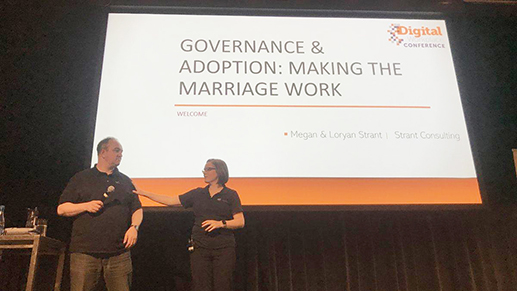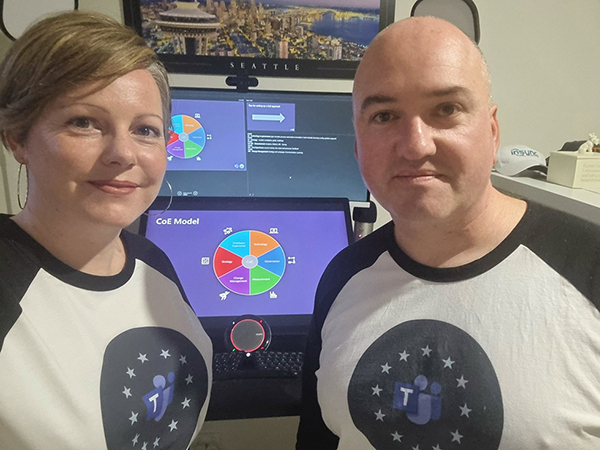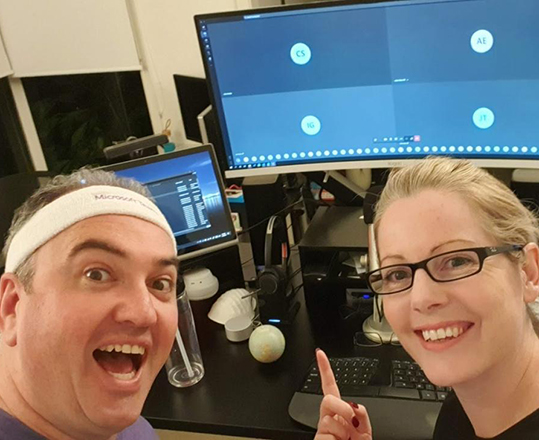Megan and Loryan Strant are passionate about their roles as busy parents to two young children. And they’re dedicated to their careers, as experienced technology professionals and Microsoft MVPs.
But in recent years, they’ve also taken on the role of passionate advocates for the millions of people who face neurodiversity challenges in their daily lives. These individuals—whether they deal with attention deficit hyperactivity disorder (ADHD), autism spectrum disorder (ASD), or another condition—must overcome significant hurdles as they tackle the myriad common tasks that most neurotypical people handle with relative ease.
These are challenges the Strants are familiar with firsthand: Loryan was first diagnosed with ADHD about two years ago, while Megan discovered she had ASD/Asperger syndrome when her daughter was screened for the condition in 2017.
“It was quite an eye-opener for me, and it made a lot of sense,” Loryan said of his diagnosis, in a talk about productivity in the age of digital overload that he and Megan gave at the 2021 Microsoft Ignite conference. “But the journey continues—just because I know I’ve got it, doesn’t mean that’s it. It’s been a bit challenging for me to accept, to understand, to work with, and to adjust to. It doesn’t define me, but it does explain a fair bit about me.”
Megan and Loryan are also both long-time Office Insiders, and have found that the productivity tools in Office have been a great help in enabling them to remain highly successful professionals while coping with their neurodiversity issues. Megan, for instance, relies on OneNote to help her record and organize large amounts of complex information, which she might otherwise struggle to retain and recall. Loryan gets excited talking about the To Do List feature that recently appeared in Outlook.
The couple recently sat down (virtually, from their home in Australia) with Susan Cockrell, senior content PM for the Office Insider program. The discussion ranged from their jobs (and how Microsoft and the Office Insider program have been instrumental to their career development), to accessibility challenges and solutions related to technology, to Loryan’s magnificent wardrobe of Microsoft swag 😊.
What are some ways that the pandemic has affected the working life of people with neurodiversity?
Loryan: I think it’s introduced new challenges. For example, having quality audio and video equipment hasn’t been a priority for people—in the office, but also from home. So when you’re in a meeting right now, and if somebody is using their webcam microphone, and like 60 percent of what I’m hearing is background noise or just reverberation—I think anybody would be struggling with it, but for people who are neurodiverse, that’s an amplified struggle. And so the challenge of switching from someone with quality audio to someone with poor-quality audio actually adds more to the cognitive load, and [results in] more exhaustion at the end of the day.
Are there any specific accessibility features in Office that you’ve found particularly helpful or valuable?
Loryan: Dark Mode for me has been an absolute savior. I honestly can’t believe I worked for most of my career without Dark Mode. From an Office Insider perspective, I think when Dark Mode came out in Word it was still kind of, dark sections but a white page. And similar with OneNote. I actually gave feedback saying, “It’s not truly dark.” And I’m sure other people gave the same.
And now, when I load it, it’s legitimately black across the entire screen. And when that first came out, I was like [gasps]. Now I’m looking at a dark screen, and it’s wonderful.
Megan: I think there’s a really wonderful, valuable feedback loop with Office Insider. And because we’re still trying to learn so much about neurodiversity and accessibility and what people need. [There are] wonderful [Office] features like Read Aloud and Immersive Text—they can really help people with dyslexia and other types of neurodiversity, or even just someone who’s having challenges with their work. So I think the feedback loop … to Office Insider can really help the technology drive change for people.
Overall, how do you feel Microsoft is doing in the area of accessibility? Are we moving in the right direction?
Megan: I can’t think of many major organizations in this industry that are doing as much as Microsoft publicly. From conferences, like the Include Conference, to the Humans of IT community, basically Microsoft is stepping ahead and leading the pack, I think, on driving awareness for accessibility and neurodiversity.
And then the [accessibility] features. I do think that they’re speeding up, and they’re learning. They’re listening to users and creating features to really help people in the workplace who have needs. So I think they are definitely doing a lot.
Loryan: I think that’s a very valid point that Megan said about how it’s speeding up. You know, Microsoft has for a long time been a proponent of accessibility, but now they’re really pushing it forward. And I think what I’d almost like to see is it not being an optional thing.
Megan: Yeah. I think one of the challenges with accessibility features is, people assume it’s not required because they can’t see anyone that has accessibility needs. But people don’t think about hidden disabilities and the challenges colleagues might be having. For example, the visual contrast in your slides, or the way you present content. If accessibility features are forced a bit more, it’s a case of, by default it’s going to do pop-ups around visual contrast and the way your slides are created. I think it would be great if accessibility becomes the norm and everyone has to just tick a box and check instead of going, “Do I think I need to bring that into my presentation? No.”
What do you think the biggest benefit of being an Office Insider is?
Loryan: The benefit of getting those features so early is the ability to kind of see that, “OK, this is a change people need to be aware of.” Apart from giving feedback before it rolls into production, it’s also to help people be prepared for, “Hey, this button is moving” or “Here’s a new button that changes things” or “You’re going to be prompted to save to OneDrive by default,” which came out a while ago. You know, that’s a change in behavior that people aren’t ready for. So I can help them with that now.
Megan: I think for an organization there’s your large product road map, or platform [strategy], which is important. But the Office Insider program gives you a peek at features and small things, and some of those are things you need to design a journey for your staff to be ready for. And some feedback to the program can really help maybe change things, to be more suitable. So I think the program really allows certain roles in the organization to dive in, play and test, and think about how does this fit into our way of working, and our organization overall.
What type of person or role gets the most value out of the Office Insider program?
Megan: It’s kind of anyone but, I mean, people within organizations who have a role to drive ways of working. You know, it’s not [just] about technical [roles], it’s also about learning and development, HR, change management, or leadership, because some things actually are quite major. I mean, look at accessibility. An organization needs to be aware of the accessibility features that are available and build awareness to drive their staff to use and understand [them]. So I think there are many roles that get benefit out of the program. 
What’s something you’ve created because of Microsoft?
Loryan: Our careers.
Megan: I think for Loryan, Microsoft enabled a business—he built a whole consulting company and a career. And I think we’ve both gained a lot from being in this community and in this industry. We have international peers, international friends, really great relationships. So there’s the broader thing we’ve gained from Microsoft. But then, day to day, in our jobs, we build products. We use our expertise, and we have a whole career based in the technology.
Loryan: I’d also say that one thing that I’ve gotten from Microsoft is an increased wardrobe. The amount of jackets, and t-shirts, and socks and everything else I’ve gotten, it’s saved me a lot of money on fashion. So thanks for being able to save lots on wardrobe costs!
Be sure to sign up for the Office Insider newsletter and get the latest information about Insider features in your inbox once a month!
